Intel's X25-V & Kingston's 30GB SSDNow V Series: Battle of the $125 SSDs
by Anand Lal Shimpi on March 19, 2010 12:00 AM EST- Posted in
- Storage
Overall System Performance using PCMark Vantage
Next up is PCMark Vantage, another system-wide performance suite. For those of you who aren’t familiar with PCMark Vantage, it ends up being the most real-world-like hard drive test I can come up with. It runs things like application launches, file searches, web browsing, contacts searching, video playback, photo editing and other completely mundane but real-world tasks. I’ve described the benchmark in great detail before but if you’d like to read up on what it does in particular, take a look at Futuremark’s whitepaper on the benchmark; it’s not perfect, but it’s good enough to be a member of a comprehensive storage benchmark suite. Any performance impacts here would most likely be reflected in the real world.
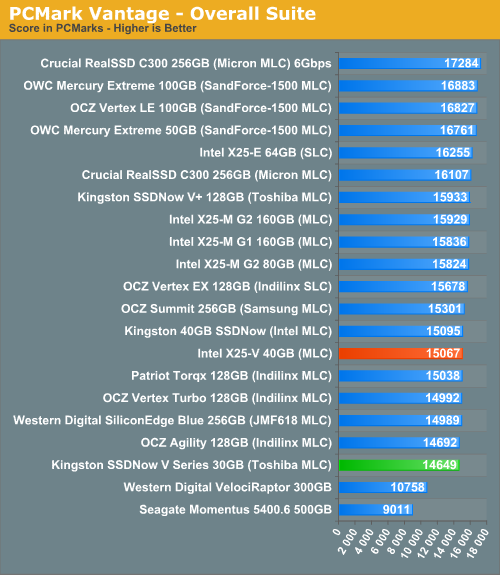
The Intel and Kingston value drives manage to stay close throughout almost all of the PCMark benchmarks. In the Productivity and HDD tests Intel manages to pull ahead by a noticeable margin however.
The memories suite includes a test involving importing pictures into Windows Photo Gallery and editing them, a fairly benign task that easily falls into the category of being very influenced by disk performance.
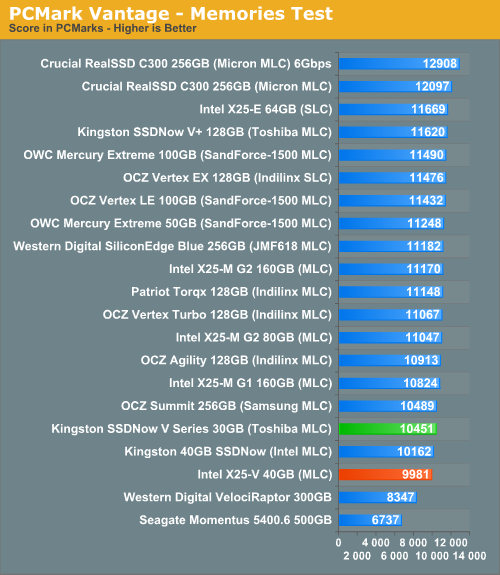
The TV and Movies tests focus on on video transcoding which is mostly CPU bound, but one of the tests involves Windows Media Center which tends to be disk bound.
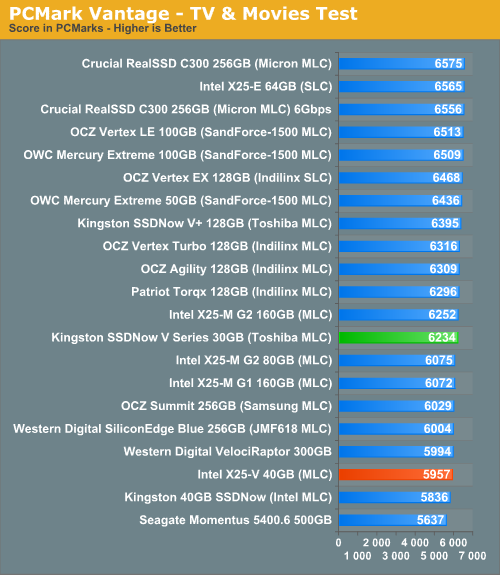
The gaming tests are very well suited to SSDs since they spend a good portion of their time focusing on reading textures and loading level data. All of the SSDs dominate here, but as you'll see later on in my gaming tests the benefits of an SSD really vary depending on the game. Take these results as a best case scenario of what can happen, not the norm.
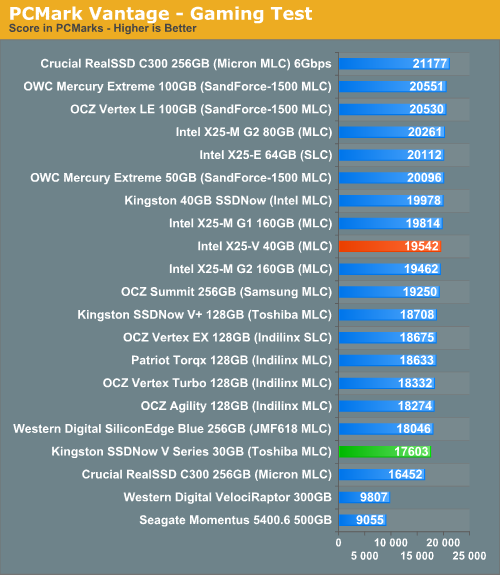
In the Music suite the main test is a multitasking scenario: the test simulates surfing the web in IE7, transcoding an audio file and adding music to Windows Media Player (the most disk intensive portion of the test).
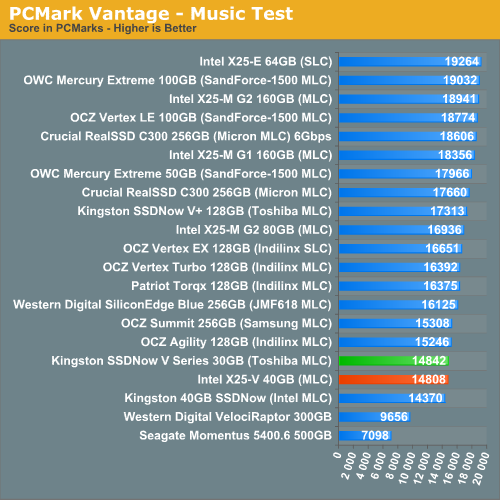
The Communications suite is made up of two tests, both involving light multitasking. The first test simulates data encryption/decryption while running message rules in Windows Mail. The second test simulates web surfing (including opening/closing tabs) in IE7, data decryption and running Windows Defender.
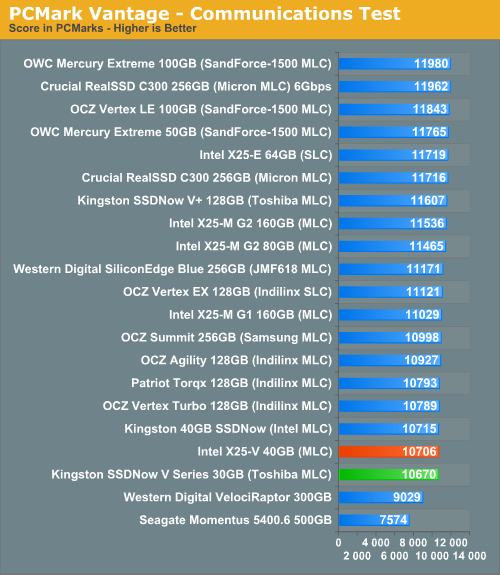
I love PCMark's Productivity test; in this test there are four tasks going on at once, searching through Windows contacts, searching through Windows Mail, browsing multiple webpages in IE7 and loading applications. This is as real world of a scenario as you get and it happens to be representative of one of the most frustrating HDD usage models - trying to do multiple things at once. There's nothing more annoying than trying to launch a simple application while you're doing other things in the background and have the load take forever.
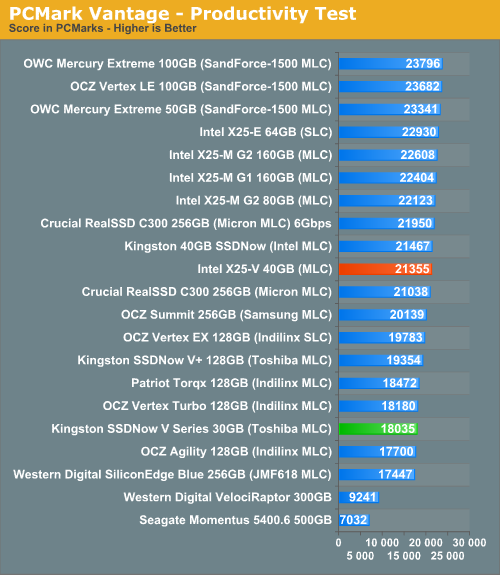
The final PCMark Vantage suite is HDD specific and this is where you'll see the biggest differences between the drives:
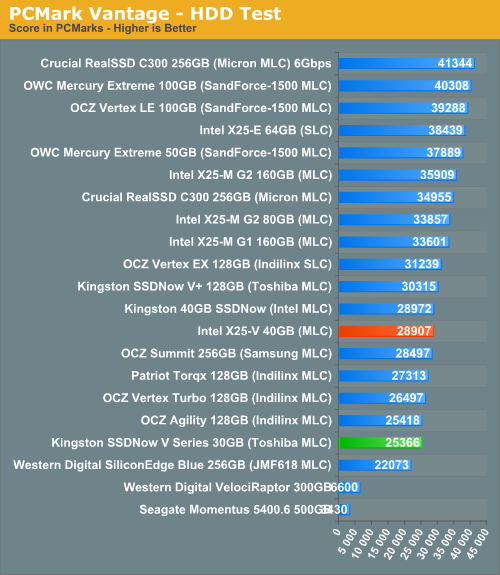










78 Comments
View All Comments
Anand Lal Shimpi - Friday, March 19, 2010 - link
No, unfortunately it looks like the bracket keeps the drive centered, which positions the SATA connectors too far to the middle to work properly in 3.5" carriers like what Apple uses for the Mac Pro.Take care,
Anand
Drakino - Friday, March 19, 2010 - link
Thanks for the response. If you can pass some feedback to the manufacturers, can you let them know this is one of the big reasons I haven't jumped on a SSD yet? A SATA compliant 3.5 inch solution would be appreciated by those of us using cableless drive setups. I know HP shipped a few VoodooPC gaming rigs with similar drive bays.I'm still really tempted to pick one of these up, but not sure how I can get it in my system without just dangling the drive on the connector.
Nomgle - Wednesday, March 24, 2010 - link
See below - Icy Dock make two adaptors that'll fit your Mac Pro just fine :)vol7ron - Friday, March 19, 2010 - link
Anand,Though I'm still operating almost all my machines on XP, I thought you said you were going to start doing all your benchmarks in Win7.
I appreciate doing both in this example, but that's got to be a lot of time spent doing it on multiple machines.
vol7ron
PS
This article really interests me when thinking about building an HTPC. I know I'll need a lot of storage space - I hope to have 4TB worth - but having a quick, speedy, small drive would be a loading dream. Thanks for the review.
Itomerou - Friday, March 19, 2010 - link
I really enjoyed the article and am always impressed with the level of detail that is done when testing and comparing components. However, the only problem with this article is that when comparing queue depth and light/heavy workload averaging the results provides no value in so far as the distribution of IOPS is not normally distributed. Additionally, the fact that these drives are completely different in their drivers and priority addressing of queue requests to say that one drive is able to server requests faster depends on the fact that measurement of requests served fits the drives exact distribution of requests served. This is apparent with the charts of how each drive performs for sequential and random access. Finally, in order to make substantial claims confidence intervals must also be constructed otherwise how accurate are the results?On the otherhand I am still intrigued with the findings.
Zelog - Friday, March 19, 2010 - link
Look at the size of the kingston, it's tiny! Now you don't even need dedicated 2.5" space for the drive, making the htpc/laptop/net book even smaller. It is definitely worth its price in the right settings.GeorgeH - Friday, March 19, 2010 - link
That was my first thought, but with a slightly different angle. If Kingston made a custom form factor you could extend laptops with dual storage below ~15". In something like the M11x you could have one of these as a fast boot drive while using a big and slow HDD with aggressive power management to get more storage, faster storage, and longer battery life.(Yes, I'm aware of mini-PCIe (and other custom connection) SSDs for netbooks and other SFF devices, but the performance there is terrible.)
Shadowmaster625 - Friday, March 19, 2010 - link
Entry level is not $125. $125 is not "cheap" or "inexpensive".davepermen - Friday, March 19, 2010 - link
it's a cheap and inexpensive SSD, and definitely the most entry level ssd existing.and yeah, if you buy an entry level desktop (not an atom), you easily pay several 100$. investing 100 more to make it perform 'really fast', is the most cheap and inexpensive way to make it perform much better.
how would YOU invest that amount of money to boost up your pc? (laptops are a different story because there storage matters actually, in a pc, just let the old hdd be plugged in too)
casteve - Friday, March 19, 2010 - link
The OCZ 30GB Agility @ $119 wins the entry level contest over these two. $99 after MIR at newegg.